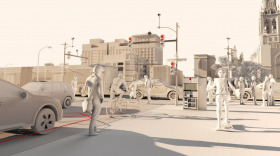- April 29th, 2022
- 0 Comments

Short for Scalable Urban Traffic Control, the first-of-its-kind artificially intelligent Surtrac system (or "adaptive traffic control") makes decisions based on what it spies through the city's traffic cameras to gather information on vehicular flow and use it to adjust traffic lights in real time. Surtrac has competition for its share of the grid from tech giants and startups alike, fortunately 22 cities are already using it, it's relatively cheap, it's easy to install and maintain, and it taps existing infrastructure like streetlight cameras.
After installation at nine intersections in Pittsburgh in 2012, travel time dropped by 26% and time spent idling at red lights by 40%. While the Pittsburgh network has grown to include 50 smart intersections – and the city plans even more – Surtrac's creators have been reworking its analytics to incorporate pedestrian data from a phone app, route info from connected vehicles, GPS pins from electric bikes and scooters, and other data on what's known as multimodal transit.
The computer at each intersection is its own node that crunches a range of scheduling options and then adjusts signal timing every second while passing insights to neighboring lights. The decentralized approach makes Surtrac ideal for regulating unpredictable urban traffic and for gradual expansion.
The system came out of Traffic21, a transportation research group at Carnegie Mellon University in Pittsburgh where residents lose an average of 45 hours to congestion every year. Though that is about 10% less than the US norm according to Texas A&M Transportation Institute's 2021 Urban Mobility Report, time spent in congestion has gotten steadily worse since the group began keeping records in 1982.
When two economists in 2011 found that whenever an urban area increases its road capacity, driving increases as well, the concept of "induced demand" has ultimately demonstrated what motorists intuitively knew – even the widest roads still get clogged.
The article states that a history of car-centric planning decisions from overbuilt streets to free parking has not only eroded many neighborhoods but also warped how we use and value city space, so to help address this point, the federal government has mandated that towns dedicate a percentage of their infrastructure investments to "complete streets" efforts that incorporate the needs and safety of pedestrians, cyclists, and transit, as well as motorists.
Smart signaling, which market analysis firm Navigant Research says will be a $3.8 billion global business by 2028, could help enable that change. If care move more efficiently across fewer lanes, then municipalities can open up the reclaimed turf. "Adaptive traffic control is making more efficient use of existing roadways and infrastructure," explains Christopher Leinberger, emiritus professor and chair of George Washington University's Center for Real Estate and Urban Analysis.
Read more about the history of this revolutionary technology and learn about what may be coming next in this lengthy, but informative article published by Popular Science this month.













